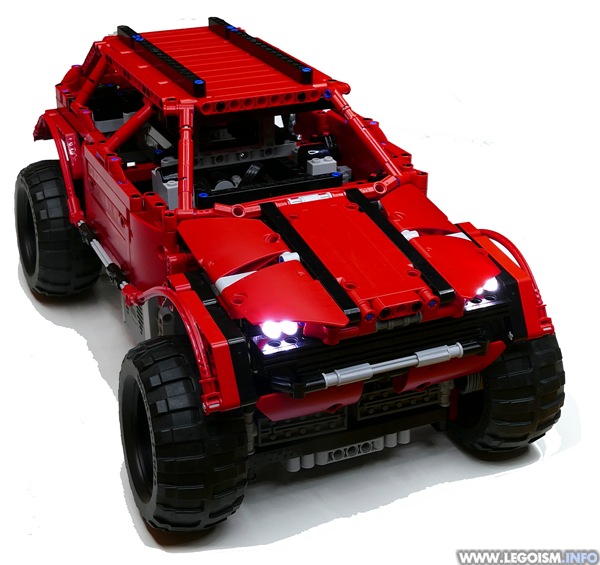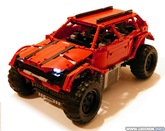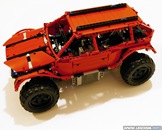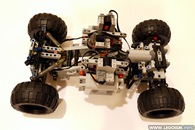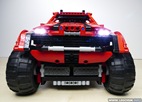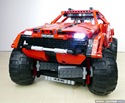As opposed to my previous off-roader, the Red Raccoon which has occupied my desk for good three months through at least five versions, this time I've had a clearer picture what I'm aiming at, therefore this GT Crawler required "only" two weeks.
 Let's begin with mechanical stuff. The intention was, among other things, to try out a combined suspension and direct-to-wheel drive. Typically, a large share of off-roaders features either a free-axle suspension or trailing arm design. The weakness of the former is that the turning axis of the front wheels changes as the chassis rises and sinks, while the latter offers, depending on the type, weak wheel independence or complex construction. This time I've tried combining these: each pair of wheels is built on a pendular axle, which is in turn connected to a large trailing arm via a turntable. The chassis is, of course, in between, along with its recentering mechanism so that the bodywork doesn't freely tilt in the curves. Since the trailing arms have been designed to offer a very large travel, there was a lot of spring required ― as much as ten were required to keep the chassis in balance (not sunk to the bottom neither forced up to the top).
Let's begin with mechanical stuff. The intention was, among other things, to try out a combined suspension and direct-to-wheel drive. Typically, a large share of off-roaders features either a free-axle suspension or trailing arm design. The weakness of the former is that the turning axis of the front wheels changes as the chassis rises and sinks, while the latter offers, depending on the type, weak wheel independence or complex construction. This time I've tried combining these: each pair of wheels is built on a pendular axle, which is in turn connected to a large trailing arm via a turntable. The chassis is, of course, in between, along with its recentering mechanism so that the bodywork doesn't freely tilt in the curves. Since the trailing arms have been designed to offer a very large travel, there was a lot of spring required ― as much as ten were required to keep the chassis in balance (not sunk to the bottom neither forced up to the top).
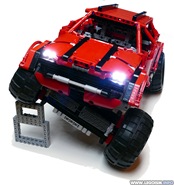 The other concept regards the drive; each wheel is connected directly to its own PF Medium motor, without any U-joints, gears or transmissions, in order to keep the mechanical losses to the minimum. This, of course, is a trivial task at the rear, but is quite a challenge at the front wheels because the motors need to turn along with the wheels during steering, implying adventures with the cables as well as a very specific construction that requires lots of room for the moving motors (which at 6x3x3 studs aren't small). And furthermore, find some more space for a PF Servo and keep everything stiff, unfortunately reducing the ground clearance somewhat. The two battery packs are placed at the sides of a rather small chassis root, and right above them, three *PF IR receivers: two for the motors (on the same channel, each pack runs its two wheels), and another one for the headlights.
The other concept regards the drive; each wheel is connected directly to its own PF Medium motor, without any U-joints, gears or transmissions, in order to keep the mechanical losses to the minimum. This, of course, is a trivial task at the rear, but is quite a challenge at the front wheels because the motors need to turn along with the wheels during steering, implying adventures with the cables as well as a very specific construction that requires lots of room for the moving motors (which at 6x3x3 studs aren't small). And furthermore, find some more space for a PF Servo and keep everything stiff, unfortunately reducing the ground clearance somewhat. The two battery packs are placed at the sides of a rather small chassis root, and right above them, three *PF IR receivers: two for the motors (on the same channel, each pack runs its two wheels), and another one for the headlights.
The bodywork, apart from the headlights as the only "function", serves no other purpose than a decorative one: the chassis can be driven just as well without it. Unfortunately, various reinforcements and PF elements in the middle eliminated any possibility of a nice interior, but that was not too much of a trouble because that would only increase the weight of an already not too light 1.9 kg. Dimensions are 48x28x24 studs, therefore very close to the 9398 4x4 Crawler (GT is slightly lower, wider and about a quarter of a kilogram heavier).
 GT Crawler drives and handles pretty fine. Although the PF Medium motors don't offer a serious torque making this car unable to climb steep hills, it is compensated by excellent torque distribution and a good maximum speed. More of a SUV than a crawler in that respect, then. The only drawback of this design is that the batteries in the packs need to be very close in charge, because any small differences in the torque on either side make the crawler slightly turn towards the weaker side if driven straight. (The option to split batteries on front and rear ends instead of the sides showed to be too complex, and would also discharge the packs unevenly through time.)
GT Crawler drives and handles pretty fine. Although the PF Medium motors don't offer a serious torque making this car unable to climb steep hills, it is compensated by excellent torque distribution and a good maximum speed. More of a SUV than a crawler in that respect, then. The only drawback of this design is that the batteries in the packs need to be very close in charge, because any small differences in the torque on either side make the crawler slightly turn towards the weaker side if driven straight. (The option to split batteries on front and rear ends instead of the sides showed to be too complex, and would also discharge the packs unevenly through time.)
GALLERY
GENESIS
YOUTUBE

